Here is an article by Chizuko Ueno, the managing director of WAN. She is discussing the super-aging society and care insurance system in Japan.
Japan’s Long-term Care Insurance System is a Savior in the Super-Aging Society
http://www.japanechoweb.jp/society-culture/jew1012
2/27/2012
2/22/2012
Global Conference for a Nuclear Power Free World 2012 Yokohama --- A Great Success!
Chizuko’s Blog No.17
January 17th, 2012
The Global Conference for a Nuclear Power Free World was held on 14-15 January at Pacifico Yokohama in Yokohama City, Kanagawa Prefecture. 5,000 people attended the conference on the first day and 5,500 on the second, with 5,000 participating in the demonstration march on the first afternoon, and an overall total of 15,500 participants from 30 different countries. WAN also attended as an advocate.
Many of the participants were younger people, who appeared to have come of their own will. Every hall, every booth was so full of energy and enthusiasm.
You can see the reports of the conference on the UStream Archives.
I made a speech at the final event of the second day. You can see the speech (in Japanese) at the following URL. (37:15 – 43:15)
Here is my draft of the speech. It is a short one of about 5 minutes.
---------------------------------------------------------------------
I’ve learned that this conference is called “Datsu-genpatsu Global Conference” [which literally means “Global Conference for Getting Away/Escaping from Nuclear Power].
The phrase “Getting away from nuclear power” makes me feel uncomfortable.
We’ve traditionally had the words “anti-nuclear/non-nuclear power.” When did they make us stop using them?
But it can’t be helped. “Getting away from” something suggests that we have experienced and passed through it. But fact is we haven’t even passed through it really.
Japan has got dirty.
Japan has experienced nuclear exposure five times in its history so far --- Hiroshima, Nagasaki, the Daigo Fukuryu Maru, JCO and Fukushima. In the first three we were the victims. In the last one we have become the perpetrators. Now we cannot blame anybody for the disaster. It is we who have contaminated the earth and life. We’ve got dirty.
That’s enough. Let’s stop doing this.
At this conference there was another thing I felt uncomfortable about. That was too much use of the words “Nippon [Japan],” “Kono kuni [this country]” and “Kono kuni no katachi [the form of this country].”
This is the “GLOBAL Conference for a Nuclear Power Free World,” not the “JAPANESE Conference for a Nuclear Power Free World”
There are two reasons for this title.
First, even if Japan can succeed in abandoning nuclear power, what will happen if Korea or China makes nuclear plants in the coastal areas and if they have accidents? Japan will be polluted too. There are no borders for the pollution. You could say that the fact that the pollution from the Chernobyl disaster spread throughout Europe has united the area.
Second, we’ve learned the lesson that peaceful and military uses of nuclear power are two sides of the same coin. Even if only Japan has the Three Non-Nuclear Principles --- not possessing, not producing and not permitting the introduction of nuclear weapons into Japan --- it is of no use if other countries have these weapons. Furthermore, the idea of coming under somebody else’s nuclear umbrella is totally out of the question. Now that you have received the Nobel Prize for Peace after the end of the Cold War, President Obama, please admit that nuclear weapons are “inhumane weapons.” Please visit Hiroshima and offer an apology.
Neither abandoning nuclear power nor abandoning nuclear weapons can be accomplished by a single country. That’s why we need to be united. That’s why we’ve gathered here beyond national borders.
Now I’ll tell you three things I’ve found out through participating in several sessions at the conference.
1. It’s OK, we can do without nuclear power.
2. It’s OK, we do have alternative and renewable energy sources.
3. But I’m not sure if this is OK; Can we ever decide on doing that?
There are people who have planned and organized this conference, to whom I’d like to express my sincere appreciation.
When I first heard about the plan, I felt it too bold. Too little time for preparation. Too big and expensive a conference site like Pacifico Yokohama. Will they ever be able to fill it up? It was so bold that I could not but help. Here is the result. The hall is full.
It’s us who made it full.
Let’s give ourselves a big round of applause.
I won't forgive media organizations if they are not going to cover this conference properly!
Here is the answer to the third thing in my list above.
We, everyone here, will decide our future.
Let’s act together.
---------------------------------------------------------------------
Original article written by Chizuko Ueno http://wan.or.jp/ueno/?p=1169
Translated by A. Tawara
★You can also see some video reports in English about the conference at the following URLs.
Opening Event
Special Closing Event
Civil Society in 2030: Drawing up the Future of Energy, Food, and Education
Toward a Nuclear Power Free East Asia
2/21/2012
Poetry -- The Art of Looking Film Review by Kei Shimizu
“The most difficult thing for me is being ready to write poetry.” I couldn’t get these words from the main character out of my mind and, for a time, it prevented me from writing this review.
This is because I doubted whether I was mature enough to face the film Poetry. “What does it mean to make a film now, when films are dying?” asks Lee Chang-dong, the director, who made this film while he was asking himself the meaning of making films and writing poetry. He asks his audience the same question.
In the film, a middle-aged woman named Mija is raising her teenage grandson while his mother is working in Pusan. Mija concerns herself with her looks and often surprises others with her unpredictable behaviors, acting just like a little girl.
The story starts when a doctor tells Mija that she is suffering from Alzheimer’s disease. At the same time, the truth of a tragic incident is revealed to her. She happens upon a poetry workshop and enrolls. There she learns that “what is essential in life is looking; it’s all about looking at the world.” She begins trying to find “authentic beauty” in what she sees in her daily life, looking at an apple in the kitchen from various angles, taking a flower by the roadside in her hand, looking from a bench up to leaves blown in the wind. In time, “looking” forces Mija to reflect upon herself and to be ready to write poetry. If Mija represents Lee and the question he has for his audience, what kind of poetry, or words, will we write to express our own answers?
The story develops without major events as it thoroughly eliminates “verbal” explanations and suppresses intense human emotions of human being. With Lee’s impressive direction, only the expressive face of Yun Junghee (as Mija) tells the story, when she leaves her grandson after playing badminton, or when she is wooed as if she were a young woman. As we watch the film, we forget about thinking or crying; we do nothing but “look.”
While she is losing her memories and words little by little, Mija identifies herself with a girl victimized by a tragic incident. Overwhelmed by her overflowing emotions, Mija finally completes her “poetry.” I expect that her poetry will touch the hearts of you readers.
At the beginning and the end of the film, there are scenes where a river flows smoothly, implying life and death. If you realize the river, represents something completely different in each scene, even though it looks the same, perhaps it means that you have found an answer to Lee’s question.
(Kei Shimizu, a junior studying film at the art department of Nihon University)
Poetry
(Lee Chang-dong, South Korea, 2010, 139min., distributed by SIGLO/ Kino Eye Japan)
Released on Feb 11 at Ginza Theatre Cinema, Shinjuku Musashino-kan, etc.
(C)2010 UniKorea Culture & Art Investment Co. Ltd. and PINEHOUSE FILM.
Visit the official website: http://poetry-shi.jp/
Original article: http://wan.or.jp/reading/?p=6038
Translated by N. Tajima
This is because I doubted whether I was mature enough to face the film Poetry. “What does it mean to make a film now, when films are dying?” asks Lee Chang-dong, the director, who made this film while he was asking himself the meaning of making films and writing poetry. He asks his audience the same question.
In the film, a middle-aged woman named Mija is raising her teenage grandson while his mother is working in Pusan. Mija concerns herself with her looks and often surprises others with her unpredictable behaviors, acting just like a little girl.
The story starts when a doctor tells Mija that she is suffering from Alzheimer’s disease. At the same time, the truth of a tragic incident is revealed to her. She happens upon a poetry workshop and enrolls. There she learns that “what is essential in life is looking; it’s all about looking at the world.” She begins trying to find “authentic beauty” in what she sees in her daily life, looking at an apple in the kitchen from various angles, taking a flower by the roadside in her hand, looking from a bench up to leaves blown in the wind. In time, “looking” forces Mija to reflect upon herself and to be ready to write poetry. If Mija represents Lee and the question he has for his audience, what kind of poetry, or words, will we write to express our own answers?
The story develops without major events as it thoroughly eliminates “verbal” explanations and suppresses intense human emotions of human being. With Lee’s impressive direction, only the expressive face of Yun Junghee (as Mija) tells the story, when she leaves her grandson after playing badminton, or when she is wooed as if she were a young woman. As we watch the film, we forget about thinking or crying; we do nothing but “look.”
While she is losing her memories and words little by little, Mija identifies herself with a girl victimized by a tragic incident. Overwhelmed by her overflowing emotions, Mija finally completes her “poetry.” I expect that her poetry will touch the hearts of you readers.
At the beginning and the end of the film, there are scenes where a river flows smoothly, implying life and death. If you realize the river, represents something completely different in each scene, even though it looks the same, perhaps it means that you have found an answer to Lee’s question.
(Kei Shimizu, a junior studying film at the art department of Nihon University)
Poetry
(Lee Chang-dong, South Korea, 2010, 139min., distributed by SIGLO/ Kino Eye Japan)
Released on Feb 11 at Ginza Theatre Cinema, Shinjuku Musashino-kan, etc.
(C)2010 UniKorea Culture & Art Investment Co. Ltd. and PINEHOUSE FILM.
Visit the official website: http://poetry-shi.jp/
Original article: http://wan.or.jp/reading/?p=6038
Translated by N. Tajima
2/01/2012
From the Scene of Protesting the Construction of Kaminoseki Nuclear Power Plant
Just past 3pm on March 11, 2011, a call was made to Tanoura Beach from Iwaishima. “We just had an earthquake. Please evacuate the beach immediately for fear of possible tsunami.” Upon hearing this announcement, young people on the beach hurriedly took their kayaks and other important leisure items to the nearby hilltops, and approximately half of them returned to Iwaishima for safety.
With the breaker out in the sea, there were fewer people than usual on this particular day in Tanoura.
Pillars and stakes are remains from the net and ropes erected by Chuden to stop the protesters from coming down the slope to the beach, and the oil fence was an underwater curtain which Chuden tried to install in the bay to stop the people from Iwaishima to land on Tanoura Beach by boats.
It was truly a sneak attack. At 2:00am on February 21, men in uniforms marched on mountain roads in darkness, headed for Tanoura. The number of uniformed men may have been 400 or even 500. In any case, at 3:00am, the first group of fishermen left the port of Iwaishima upon receiving the urgent report. At the same time, the Kayak Group laid their bodies on the line trying to stop Chuden from entering Tanoura Beach. At 4:00am, the first group from Iwaishima and people from nearby areas began to gather on the beach. There were pushing and shoving with Chuden on one side trying to blockade the beach and the protesters on the other trying to stop them. The security guards Chuden hired for this purpose were all huge and muscular men and when they formed a human barrier around the Chuden workers, “It was no easy task to get through this barrier. My body was bruised up and some of us got heavy elbow blows,” said a young woman from the Kayak Group.
The boats from Iwaishima, which stood by cautiously until then, protested violently and some of the Chuden ships left, but the workers who remained began pouring gravel into the sea to lay grounds for building the nuclear power plant. “Don’t pollute our source of livelihood with dirty gravel!” Mr. Shimizu, a town councilor of Kaminoseki pleaded along with others from the island. Not only the islanders’ ships were blocked by coast guards’ rubber boats, they were pushed and shoved away. (photo #7)
The duty of Japan Coast Guard is to guard and protect ships and people on the sea from danger, but it seemed to me that their main concern this day was to protect the safety of Chuden ships as the working ships continued to throw-in gravel into the sea.
(photo #8)
As always, the ship of Ministry of Economy, Trade and Industry quietly observed the scene from a distance.
(photo #9)
The gravels were thrown into the sea inside the area supposedly lined with the anti-pollution coverings, but not only did they fail to reach the bottom of the sea, they were full of holes. Fortunately the load capacity of gravel that can be carried by these working ships was limited, and the total amount of gravel thrown into the sea was considerably less for the number of ships that were there.
At the main construction site, ships from Iwaishima lined up to block off the entrance to Tanoura Bay, forbidding single working ship to enter. The effort of Chuden trying to draw an oil fence inside the bay by entering with a small boat was blocked by protesters on kayaks, rafts, and surfboards. That day, on the Tanoura Beach, over 100 people gathered for a violent protest against the blockade. A 69-year-old woman, among other islanders, was injured and carried off to a hospital that day. (photo #10)
After that, the working ships stationed in the sea began to leave for the reason of approaching ill weather, Chuden and coast guard ships also left. Tension was then focused on the protest at the beach, but eventually the battle subsided although the tension related to the plans of building the nuclear power plant will continue.
On March 15, Chuden complied with the request of Yamaguchi Prefectural Governor and Kaminoseki-cho Mayor and announced it will temporarily stop the groundwork of the nuclear power plant construction site, however, they continued the blasting operation on the pretext of “investigation.” The reality was that they were filling the valleys with gravels and dirt made by the blast and developing the site for the plant.
According to Chuden’s publicity department, the “temporary break” of groundwork construction referred to the “development of the site," and therefore, they insisted they are not telling a lie. On March 22, people objecting the Kaminoseki power plant made an appeal to Chuden Headquarter and Yamaguchi prefectural government and demanded all constructions, including blasting, to stop. The response to this appeal was that the blasting was necessary for investigating the safeness of the nuclear power plant in accordance with the regulations set by the national government; and therefore, “We will continue,” commented Chuden, and “Whether to stop the blasting or not is the decision of the national government and the company undertaking the project,” was the response from the prefectural government.
As to make things worse, Mr. Yamashita, President of Chuden, announced at the press conference held by on March 28 that they will “carry on the project as planned,” which further induced the anxiety of people fearing the effect of earthquakes on the nuclear power plant. The following day, people of Iwaishima and Kayak Group protested at Tanoura. In the unified local election in April, Kaminoseki nuclear power plant project was the main issue of focus by the candidates of surrounding local governments, and a newcomer, Hideto Kunihiro, born and raised in Iwaishima, independently ran for the office of prefectural councilor from Hikari City, 30 kilometers away from the designated plant site. He came very close to two incumbent candidates and lost by mere 197 votes. His catch phrase was, “We are the ones who will create the future - let’s unite in saying no nuclear power plants in the future.” Those who supported Mr. Kunihiro in this election have since then continued to demonstrate against building nuclear power plant by demanding “life without nuclear power.”
Generations of people on Iwaishima lived with the blessing from the sea ever since the island became a key spot for the maritime traffic. The island is located 3.5 km directly across the sea from Tanoura in Kaminoseki, Yamaguchi Prefecture where Chugoku Electrical Company (Chuden) has planned to build a nuclear power plant.
(see photo #0)
(see photo #0)
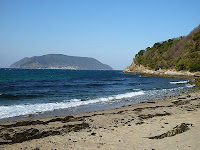 |
| Photo #0 |
28 years ago when the plan first arose, about 90% of the islanders rejected the plan and the fishing association refused to accept the compensation of 1 billion yen. Since January 2010, people have been going to Tanoura daily to protest, except on stormy days because the average age of these people is 79 and mainly women, they cannot cross the rough waters under bad weather. There are some “young men” on the island in their 50s who support these women.
There is a group that do protest in Tanoura even on stormy days, and they are known as Niji no Kayak Group (Rainbow Kayak Group). They are sometimes called Kayaks and made up of young men and women in their 20-30s. They are not an organized group, but rather people from various parts of Japan who come together and support Iwaishima people for a mutual cause. Because the group is not bounded by strict rules and regulations and the members come together voluntarily, independently, and without restrictions, they are able to respect the activities and supplement the lack of manpower of the islanders.
 |
| Photo #1 |
With the breaker out in the sea, there were fewer people than usual on this particular day in Tanoura.
(photo #1)
The only evidence of violent protest against the nuclear plant that took place here merely 10 days ago are pillars of net fences, several stakes, and oil fences floating in the sea. (photos #2-4 below)
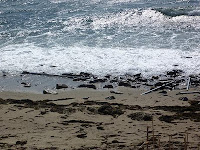 |
| Photo #2 |
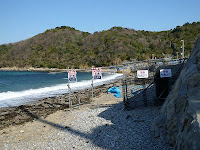 |
| Photo #4 |
Pillars and stakes are remains from the net and ropes erected by Chuden to stop the protesters from coming down the slope to the beach, and the oil fence was an underwater curtain which Chuden tried to install in the bay to stop the people from Iwaishima to land on Tanoura Beach by boats.
It was expected to be a dynamic crash that could have been called Sea Battle of Kaminoseki. On February 1, Chuden announced that Kaminoseki Nuclear Power Plant Project was under a direct control of the president. The operation ships for building the plant had been obstructed several times by Iwaishima residents and Kayak Group since last fall and almost daily this year when the weather permitted. The act of protesters to obstruct Chuden’s ships to land on Tanoura persisted to the extent that Chuden referred to these acts as “sabotage” rather than the initial act of “demonstration” and has filed lawsuit against the local residents. The day after the announcement, an employee of Chuden on one of the working ships claimed that a fisherman from Iwaishima was swinging a knife on his boat. This incident developed into a highly volatile political situation and Japan Coast Guard was brought into the scene and interrogated the fisherman for 5 hours. Thereafter, the Coast Guard inspected all of the boats that came to protest. As a result of worsening the conflict by fanning the opposition, Chuden proceeded with the construction of the nuclear power plant by force.
It was truly a sneak attack. At 2:00am on February 21, men in uniforms marched on mountain roads in darkness, headed for Tanoura. The number of uniformed men may have been 400 or even 500. In any case, at 3:00am, the first group of fishermen left the port of Iwaishima upon receiving the urgent report. At the same time, the Kayak Group laid their bodies on the line trying to stop Chuden from entering Tanoura Beach. At 4:00am, the first group from Iwaishima and people from nearby areas began to gather on the beach. There were pushing and shoving with Chuden on one side trying to blockade the beach and the protesters on the other trying to stop them. The security guards Chuden hired for this purpose were all huge and muscular men and when they formed a human barrier around the Chuden workers, “It was no easy task to get through this barrier. My body was bruised up and some of us got heavy elbow blows,” said a young woman from the Kayak Group.
Once the sun started to rise, a number of Chuden working ships began to appear on the shores ofTanoura. (see photos #5 & 6)
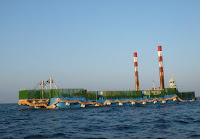 |
| Photo #5 |
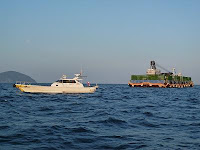 |
| Photo #6 |
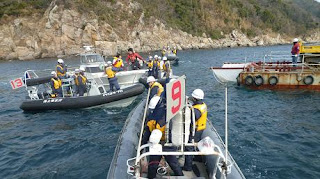 |
| Photo #7 |
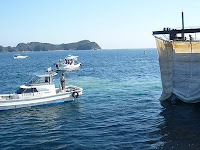 |
| Photo #8 |
(photo #8)
 |
| Photo #9 |
(photo #9)
The gravels were thrown into the sea inside the area supposedly lined with the anti-pollution coverings, but not only did they fail to reach the bottom of the sea, they were full of holes. Fortunately the load capacity of gravel that can be carried by these working ships was limited, and the total amount of gravel thrown into the sea was considerably less for the number of ships that were there.
At the main construction site, ships from Iwaishima lined up to block off the entrance to Tanoura Bay, forbidding single working ship to enter. The effort of Chuden trying to draw an oil fence inside the bay by entering with a small boat was blocked by protesters on kayaks, rafts, and surfboards. That day, on the Tanoura Beach, over 100 people gathered for a violent protest against the blockade. A 69-year-old woman, among other islanders, was injured and carried off to a hospital that day. (photo #10)
 |
| Photo #10 |
The devastating earthquake and tsunami that suddenly occurred this day, which triggered the great big accident of Fukushima #1 plant, changed the lives of countless number of people in Eastern Japan. While deeply sympathetic to the occurrence of this shocking event, excitement spread at the site of where considered to be the location for the last nuclear power plant to be built in Japan.
On March 15, Chuden complied with the request of Yamaguchi Prefectural Governor and Kaminoseki-cho Mayor and announced it will temporarily stop the groundwork of the nuclear power plant construction site, however, they continued the blasting operation on the pretext of “investigation.” The reality was that they were filling the valleys with gravels and dirt made by the blast and developing the site for the plant.
According to Chuden’s publicity department, the “temporary break” of groundwork construction referred to the “development of the site," and therefore, they insisted they are not telling a lie. On March 22, people objecting the Kaminoseki power plant made an appeal to Chuden Headquarter and Yamaguchi prefectural government and demanded all constructions, including blasting, to stop. The response to this appeal was that the blasting was necessary for investigating the safeness of the nuclear power plant in accordance with the regulations set by the national government; and therefore, “We will continue,” commented Chuden, and “Whether to stop the blasting or not is the decision of the national government and the company undertaking the project,” was the response from the prefectural government.
As to make things worse, Mr. Yamashita, President of Chuden, announced at the press conference held by on March 28 that they will “carry on the project as planned,” which further induced the anxiety of people fearing the effect of earthquakes on the nuclear power plant. The following day, people of Iwaishima and Kayak Group protested at Tanoura. In the unified local election in April, Kaminoseki nuclear power plant project was the main issue of focus by the candidates of surrounding local governments, and a newcomer, Hideto Kunihiro, born and raised in Iwaishima, independently ran for the office of prefectural councilor from Hikari City, 30 kilometers away from the designated plant site. He came very close to two incumbent candidates and lost by mere 197 votes. His catch phrase was, “We are the ones who will create the future - let’s unite in saying no nuclear power plants in the future.” Those who supported Mr. Kunihiro in this election have since then continued to demonstrate against building nuclear power plant by demanding “life without nuclear power.”
There is no leeway for the “continuation of yesterday’s incident” in national nuclear power policy. As apparent by the announcement “to reconsider the plan for energy supply” made by the Prime Minister on May 10, the situation of nuclear power plant accident is, no doubt, very serious. However, ignoring this announcement, Chuden reported the result of environmental survey of the groundwork construction of the plant site the day after the Prime Minister’s announcement. Perhaps they felt stagnated by the rocking situation in the national policy, but at the same time, they probably needed to re-assure themselves to move forward with their project.
In the western entrance of Seto Inland Sea, the aftermaths of the Great Eastern Japan Earthquake continue, but what is shaking is the people and the nuclear power plant plan. It is frightening to feel the earth tremble, and we need to shake away the plan already in 29th year by taking into consideration the sentiment of disaster victims of Eastern Japan earthquake and tsunami, and to prevent another nuclear power plant accident from occurring in the future.
Original article written by Shin Yamaaki, translated and adapted by M. Doioka
Subscribe to:
Posts (Atom)